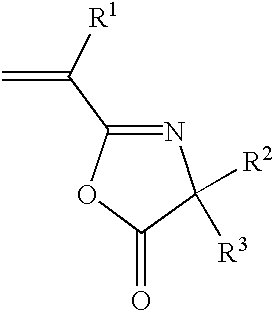Liquid inks comprising a stable organosol
a liquid ink and organosol technology, applied in the field of liquid ink compositions, can solve the problems of adding both an extra cost of materials and extra process steps to apply the protective layer, and tacking the image on the final receptor
- Summary
- Abstract
- Description
- Claims
- Application Information
AI Technical Summary
Benefits of technology
Problems solved by technology
Method used
Image
Examples
examples
Glossary of Chemical Abbreviations & Chemical Sources
[0078] The following raw materials were used to prepare the polymers in the examples which follow:
[0079] The catalysts used in the examples are Azobisisobutyronitrile (designated as AIBN, commercially obtained as VAZO.TM.-64 from DuPont Chemicals, Wilmington, DE); Dibutyl Tin Dilaurate (designated as DBTDL, commercially obtained from Aldrich Chemical Co., Milwaukee, Wis.); and 2,2'-Azobisisobutyronitrile (designated as AZDN, commercially obtained from Elf Atochem, Philadelphia, Pa.). The monomers are all available from Scientific Polymer Products, Inc., Ontario, N.Y. unless designated otherwise.
[0080] The monomers used in the examples are designated by the following abbreviations: Dimethyl-m-isopropenyl benzylisocyanate (TMI, commercially obtained from CYTEC Industries, West Paterson, N.J.); Ethyl Acrylate (EA); 2-Ethylhexyl Methacrylate (EHMA); 2-Hydroxyethyl Methacrylate (HEMA); 3,3,5-trimethylcyclohexyl methacrylate (TCHMA); la...
example 1
[0105] To a narrow-mouthed glass bottle (32 ounce; 907 ml) was charged 483 g of Norpar.TM. 12, 80 g of LMA, 80 g of TCHMA, 3 g of 98% HEMA, and 0.95 g of AZDN. The bottle was purged for 1 minute with dry nitrogen at a rate of approximately 1.5 liters / min, then sealed with a screw cap fitted with a Teflon liner. The cap was secured in place using an electrical tape. The sealed bottle was then inserted into a metal cage assembly and installed on the agitator assembly of an Atlas Launder-Ometer (commercially obtained from Atlas Electric Devices Company, Chicago, Ill.). The Launder-Ometer was operated at its fixed agitation speed of 42 rpm with a water bath at a temperature of 70.degree. C. The mixture was allowed to react at 70.degree. C. for 17 hours, heated to 90.degree. C. for 1 hour to destroy any residual AZDN, and cooled to room temperature. The conversion of monomer to polymer was quantitative. The bottle was then opened and 2.6 g of 95% DBTDL and 7.8 g of TMI were added to the ...
example 2
[0107] Example 2 was prepared according to the procedure for Example 1 except that TCHMA was replaced by IBMA; and that the amounts of 98% HEMA and AZDN were increased to 5.1 g and 1.57 g respectively. The cooled mixture was a viscous, transparent solution, containing no visible insoluble mater.
[0108] The product is a copolymer of LMA, IBMA and HEMA containing random side chains of TMI and can be used to prepare non-gel organosols. It is designated herein as LMA / IBMA / HEMA-TMI (48.5 / 48.5 / 3-4.7 w / w %). It was tested according to the methods described in the Test Method section. The percent of solids was 25.55%. The copolymer had a M.sub.w of 146,500 Da and a M.sub.w / M.sub.n of 1.97.
PUM
| Property | Measurement | Unit |
|---|---|---|
| weight average molecular weight | aaaaa | aaaaa |
| weight average molecular weight | aaaaa | aaaaa |
| diameter | aaaaa | aaaaa |
Abstract
Description
Claims
Application Information
 Login to View More
Login to View More - R&D
- Intellectual Property
- Life Sciences
- Materials
- Tech Scout
- Unparalleled Data Quality
- Higher Quality Content
- 60% Fewer Hallucinations
Browse by: Latest US Patents, China's latest patents, Technical Efficacy Thesaurus, Application Domain, Technology Topic, Popular Technical Reports.
© 2025 PatSnap. All rights reserved.Legal|Privacy policy|Modern Slavery Act Transparency Statement|Sitemap|About US| Contact US: help@patsnap.com

